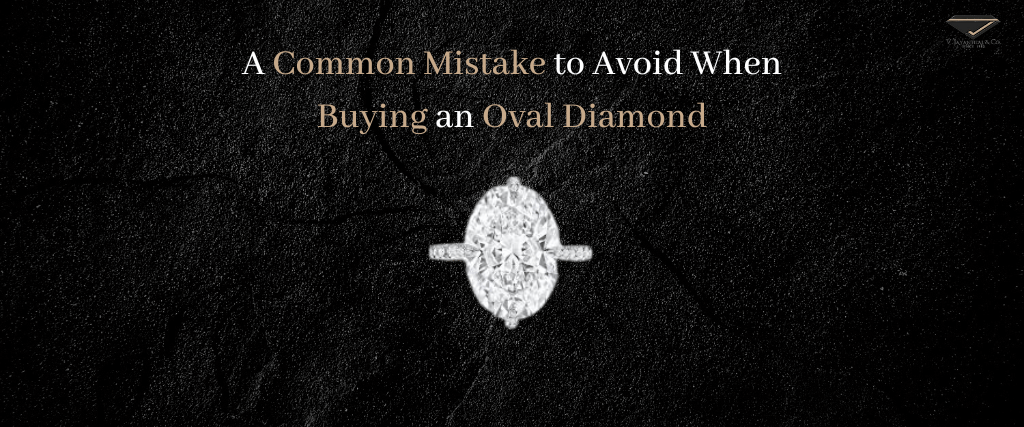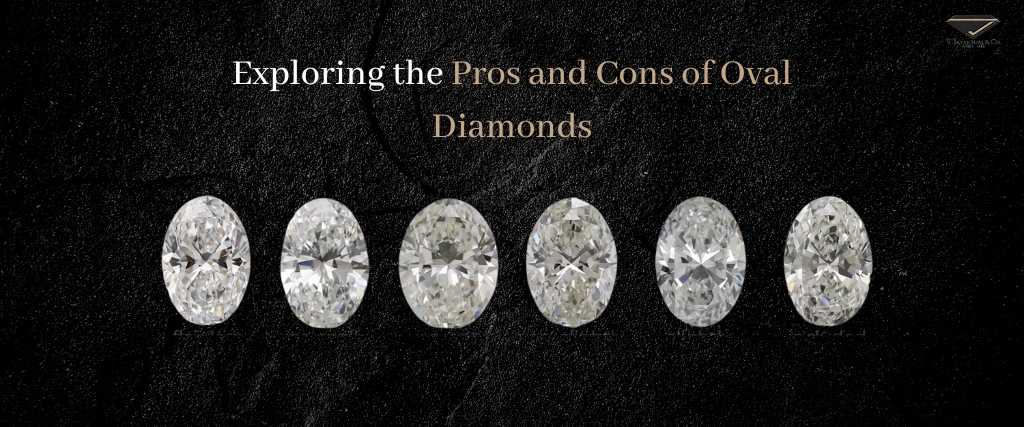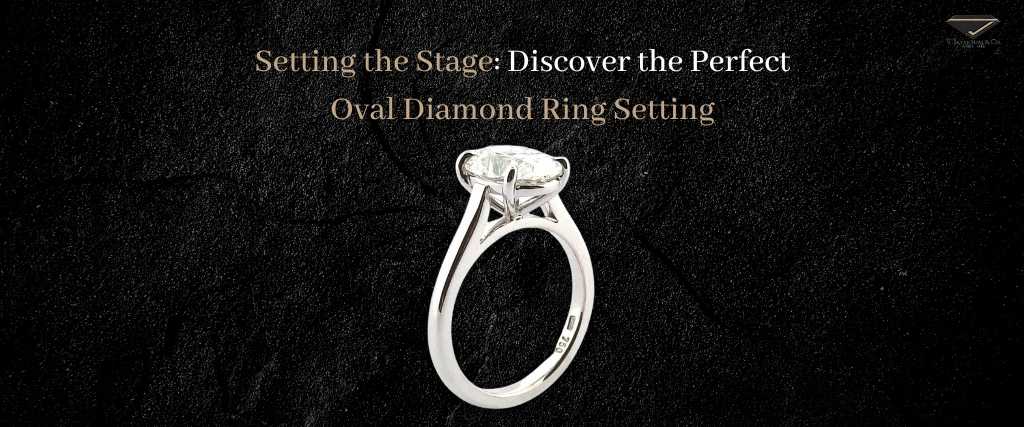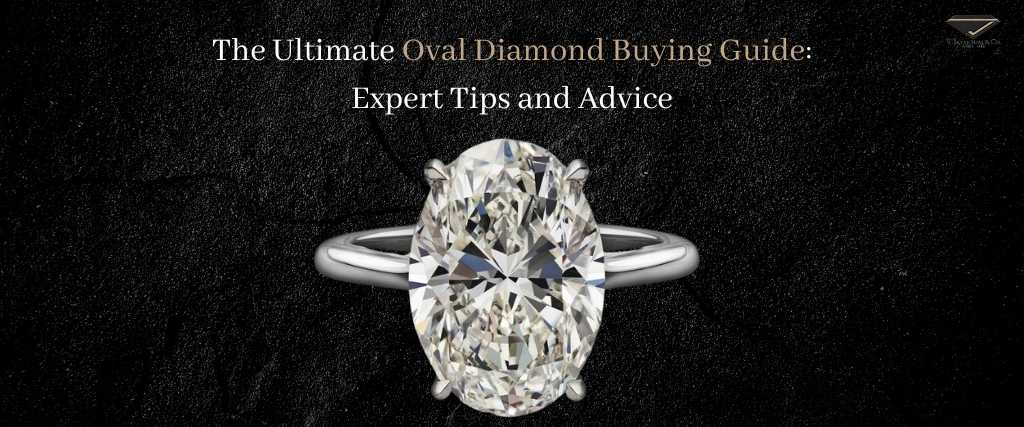
Choosing the perfect oval diamond is an exhilarating yet intricate process that involves navigating through a myriad of considerations to ensure you make a wise and satisfying purchase. The allure of the oval shape lies in its elegant and elongated form, often praised for its ability to create an illusion of length on the finger.
However, the journey to finding the ideal oval diamond is not without its challenges, as there are common pitfalls that prospective buyers may encounter.
In this blog, we will delve into the intricate details of the common oval diamond buying mistakes. From the essential considerations of the Four Cs – Cut, Color, Clarity, and Carat weight – to the often overlooked aspects like length-to-width ratio, bowtie effect, and symmetry, each facet contributes to the overall beauty and value of the diamond.
By understanding and sidestepping these potential pitfalls, you can empower yourself to make an informed and confident choice, ensuring that the oval diamond you select not only meets your expectations but also becomes a timeless symbol of elegance and enduring beauty.
Join us on this insightful journey to unravel the intricacies of oval diamond selection, and discover the keys to making a purchase that reflects your unique style, values, and budget constraints.
To help you make an informed decision, let's delve into the details of these oval diamond buying mistakes and how to avoid them.
Also Read- The Ultimate Oval Diamond Buying Guide: Expert Tips and Advice
A certified diamond provides a guarantee of quality and authenticity. Reputable gemological laboratories like GIA and AGS assess the characteristics of the diamond and provide a certification report.
To avoid oval diamond buying mistakes, always ask for and verify the diamond's certification to ensure that the diamond's description matches what you're purchasing.
The length-to-width ratio significantly influences the diamond's overall appearance. Oval diamonds come in various ratios, with a classic range typically falling between 1.30 to 1.50. However, personal preference plays a critical role.
Some prefer a more elongated oval, while others prefer a balanced shape. To avoid this oval diamond buying mistakes, choose the best oval diamond ratio that aligns with your aesthetic taste.
The bowtie effect is a shadow or dark area that may appear in the center of some oval diamonds due to their cut. To avoid disappointment, carefully inspect the diamond in various lighting conditions to assess the presence and intensity of the bowtie effect.
A well-cut oval diamond should have a minimal or imperceptible bowtie effect, as it can detract from the diamond's beauty.
Good symmetry is vital for oval diamonds, directly influencing their overall appearance. Check if the diamond's two halves are mirror images of each other and if the points at each end align correctly.
To avoid oval diamond buying mistakes, ensure that the diamond you choose displays excellent symmetry, as poor symmetry can result in an unattractive or unbalanced oval shape.
The choice of setting has a considerable impact on how the oval cut diamond looks when worn. Different settings complement oval diamonds differently. Halo settings, solitaires, and three-stone settings are popular choices.
Ensure that the chosen setting enhances the diamond's appearance, complements your style, and provides security. Neglecting this aspect can result in a less-than-ideal presentation of the diamond.
While the four Cs and other objective factors are crucial, personal preferences should not be ignored. Oval diamonds come in a variety of shapes, and individual tastes vary.
Take your time to explore various options and choose a diamond that resonates with your style and aesthetic preferences. What appeals to one person may not be the same for another.
Impulse buying is a common mistake to avoid. Rushing the purchase without adequate research and comparison can lead to regret later on. Take your time to explore different options, visit multiple jewelers or browse reputable online retailers, and gather information to make an informed decision.
A well-thought-out purchase is more likely to result in a diamond that meets your expectations.
Also Read - 9 Reasons to Buy Oval Shape Diamond
While sticking to your budget is essential, obsessing solely over the Oval diamond price factors can lead to sacrificing quality.
Consider the value you're getting for your budget. Prioritize the factors that matter most to you. It's worth investing in a quality oval diamond that aligns with your preferences and that you'll cherish for a lifetime.
Be cautious about buying oval diamond online. Purchase from reputable jewellers with a history of ethical practices and quality products.
Read reviews, ask for referrals, and ensure that the seller provides a clear return and exchange policy. Avoid buying from unknown or unverified sources, as it can lead to disappointment and potential issues down the road.
Purchasing an natural oval diamond involves careful consideration of multiple factors, including the four Cs, personal preferences, and budget constraints.
Avoiding common oval diamond buying mistakes, such as neglecting the four Cs, ignoring certification, and not considering the length-to-width ratio, is crucial to ensuring that your oval diamond is a stunning and valuable investment.
Take your time, do thorough research, and select a diamond that aligns with your style, values, and financial capacity.
At V. Jayantilal & co., we are passionate about providing high-quality oval diamonds in different carat sizes and the best customer service.

Nothing makes an impression like a diamond; other jewels might be impressive, but there is something unique about a diamond that is classy and brilliant.
People continue to be drawn to diamonds of various clarity, color, carats, and cuts because of this indescribable quality. This includes diamonds with oval cuts and symmetrical gems that sparkle and are charming. Oval-cut diamonds are stylish and sophisticated.
At V. Jayantilal & Co., we offer a huge range of GIA-certified diamonds to all our clients in need, including a wide selection of oval-cut options.
Before adding one to your anniversary necklace or engagement ring, what exactly should you think about? This guide will walk you through the basics and explore the pros and cons of oval diamonds to ensure your diamond is one you’ll treasure forever.
The oval-cut diamond was created in the early 1960's by Lazare Kaplan. Despite having a more elongated shape and some similarities to the round diamond, the oval can appear larger than its actual carat weight.
The elongation of an oval-shaped diamond is what allows an oval to appear larger than its actual weight and it's the reason why many lean towards oval-cut diamond engagement rings.
There are many advantages of oval shaping diamonds, here are the main benefits:
You may get a larger diamond for your budget since an oval-cut diamond will be less expensive than a round-cut diamond same carat and clarity. Up to 30% less money might be spent on an oval-cut diamond than on a round diamond.
If you like a setting with a large diamond, an oval-cut diamond is a fantastic cheap alternative since its larger surface area makes it appear larger than a round cut of the same size.
Also Read: Setting the Stage: Discover the Perfect Oval Diamond Ring Setting
A diamond’s sparkle and brilliance are determined by the way it is cut, and the oval cut is one of the brightest cuts of all. When you choose a ring with an oval-cut center stone, you are guaranteed a brilliant sparkle on your finger.
If you are searching for a slimming effect, the oval form of the diamond can make a woman’s fingers seem longer and slimmer. Always try different-shaped stones before making your pick to ensure the form of your ring matches your finger.
There are no sharp corners on an oval cut diamond, so it is great practical wear for every day. Any diamond with angular edges is likely to snag on objects as you go about your daily business, increasing the chance that the prongs holding the stone in place will shatter. The prongs of an oval diamond are much less prone to shatter than those of a square-cut diamond.
Not only is the oval-cut diamond a more original choice in itself, but you can also choose from a variety of settings. You can choose between a 4-prong, 6-prong, or bezel setting for an oval-cut stone. Due to the oval shape of the diamond's design, which makes it less prone to catch, a four-prong setting can be sufficient to keep the diamond secure.
Although a smaller diamond may be overshadowed by the additional metal, the six-prong setting does give the added protection of a secure grip. Alternately, a bezel setting is a strip of metal encircling the stone and holding it securely in place.
Oval-cut diamonds are a fantastic deal since they produce a stone that appears bigger than it actually is. This is so that we can trace the longest lines of an oval with our eyes and measure it from top to bottom.
In terms of actual size, an oval diamond is cut shallower than a round diamond, which means that it has more surface area, sometimes up to 10% than a round diamond.
The pros and cons of oval diamond is a fantastic choice if you're looking for a brilliant diamond because of its famed brightness and exceptional light performance. The oval cuts' faceting structure and alignment, which improves light contact, are the cause of this. Similar to the round brilliant, the oval cut features 58 carefully placed facets all over its surface.
The oval cut is a great choice if you're looking for a traditional diamond with a distinctive twist. The oval cut has a conventionally round appearance, but its elongated shape is unique.
Due to the oval cut's lengthier form, which gives the appearance of longer fingers, the wearer's fingers tend to seem thin and long. For brides with short or wide fingers, the oval is an excellent option when set vertically.
One of the benefits of oval shape diamond is its ability to hide flaws, thanks to its brilliant facets. With the oval cut, you can go lower on the clarity and color scales than you would be able to with the majority of other diamond cuts because of its forgiving nature.
We advise lowering the value for clarity to SI1 or SI2 for the best result, and for color, try lowering the value to H or even I. Remember not to go based on grading alone, but check out each diamond individually before you buy an oval diamond.
Also Read: The Ultimate Oval Diamond Buying Guide: Expert Tips and Advice
The absence of sharp corners that may catch on things or cause harm is one of the finest features of rounded diamond shapes. Only the oval, cushion, and round diamond forms are included in this group.
This can seem like a minor point, but it has an impact on the diamond's overall longevity and the available setting possibilities. It is simpler to care for and keep an oval diamond since it needs less protection than, say a princess, marquise, or a pear.
The oval diamond comes in a few distinct configurations, depending on the length-to-width ratio that you pick. You now have more options for looks and versatility. While the most frequent length-to-width ratio for oval diamonds is about 1.45, this figure may range from 1.33 (a broader oval) to 1.66 (a narrower oval). The most conventional oval cuts fall within this range, whereas those that fall outside of it result in thicker and squatter oval, respectively.
Because of the oval shape, you can also choose different orientations, from diagonal to horizontal placement of the diamond. These options are not available with a round or princess cut because these shapes are the same from all angles.
Despite the oval cut diamond's many benefits, there are a few significant drawbacks to be aware of These include:
When the cut of the stone prevents light from reflecting back from the center, bowties form. This frequently results from mismatched facets. Now, a little bit of bow tie can enhance the elegance and definition of your diamond's appearance, but it shouldn't be overdone. All oval cuts have some degree of bowtie, but if it’s the first thing you notice when you look at your diamond, it’s best to opt for a different stone.
Unfortunately, since exotic cuts like oval cuts are not graded by diamond grading laboratories, the only method to determine whether your oval diamond has a good cut is to carefully examine it and see how it responds to light. Since bowties are not included in grading reports, it is important to individually inspect each pros and cons of oval diamond before choosing one.
The oval cut does tend to highlight any flaws, blemishes, and inclusions within the diamond, so you will need a clarity of VS1 or above and a color of G or above to make the most of your purchase. The good news is that, as oval-cut diamond rings are cheaper than comparable round cuts, you can afford to invest in higher clarity and color.
If the symmetry of the oval cut isn’t perfect, the diamond can look slightly wonky or off-center. Look for mirror images with the same sides. If the stone has been cut inexpertly, it’ll show. This is why it’s not easy to find a beautifully cut oval diamond and you’ll have to spend some time searching before you find the right one.
Overall, the oval cut diamond is an excellent option if you want a larger high-quality stone with plenty of extra sparkle at an affordable price. Take care to assess the color and clarity of your chosen diamond, and you will have a unique spectacular diamond ring. Ultimately, choose a diamond you love. An oval-cut diamond may be worth the extra money if its long form and sparkling pattern make you swoon. At V. Jayantilal & co., we ensure that each of our diamond alternatives outshines in terms of color and clarity.

An oval diamond ring is the perfect choice if you want your engagement ring to look stunning. Oval Cut Diamonds are known for their uniqueness and timeless charm. Its elongated design makes it appear larger to the eye than other diamond cuts of the same carat weight.
Now that you’ve settled on the oval cut, you’ll want to be sure to select the perfect setting for it. There are a variety of oval diamond ring settings, so long as you tailor them to the shape and demands of the center stone.
As the name suggests, an oval-cut diamond is a symmetrical, elongated, and rounded shape. With their larger surface area. If you prefer a bigger diamond, an oval cut makes an impressive and economical option. Its slender shape can also make the finger appear longer and slimmer. An oval diamond cut has triangle, star, bezel, and kite-shaped facet patterns on the table anatomy with a 60-degree angle and soft curving edges. Also, the oval cut diamond’s middle girdle facets are swallowed from the left to the right side, but the north-to-south surfaces are narrower. This makes oval-shaped engagement rings an ideal selection for all ring styles.
The oval diamond is egg-shaped because its faceting patterns aren’t matched in other shapes of structures like squares or rectangles. An oval-shaped diamond has 57 facets on the crown, girdle, and pavilion anatomy.
There are three reasons to choose an oval-cut diamond for an engagement ring: the attractive faceting patterns, more length, and being the best alternative to round-cut diamonds. The factors mentioned above play a vital role in oval-cut diamond engagement rings.
Let’s understand them in depth.
An oval diamond has four numbers of shapes facets triangles, bezels, stars, and kites. These shaped facets help the diamond anatomy receive and issue the most precious lightning resonations in a proper way. The brilliance reflection in an oval diamond cut depends on the faceting patterns. That’s all.
The fancy-shaped faceting patterns make the oval-shaped rings preferable for engagements. In all engagement ring settings, the oval diamond shape sustains and preserves the brilliant reflections; that are eye-catching for anyone.
Oval and emerald diamond cuts have the same length because they have been used as an alternative option. The reason for the oval diamond's length is that it has soft banding edges that comply with the girdle and crown anatomy.
The length of the oval-cut diamond is acceptable for solitaire to halo settings in all gold variations.
While talking about an emerald-cut diamond’s length, a parallel facet is responsible for that. Due to the parallel faceting patterns, it needs more space to determine the flow of light reflections.
The fact is that 90°-angled faceting styles are found in the emerald diamond cut. Therefore, the emerald diamond cut has more length.
The oval diamond cut is an alternative to the round diamond cut because they have the same facets in their anatomy. But an oval-shaped diamond has one more benefit than a round cut. The oval diamond has a length that covers the size of the finger in the engagement ring.
For this reason, an oval diamond is used as an alternative to a round diamond. The price for a round cut and an oval diamond shape isn't the same. The oval diamond shape is cheaper than the round-cut diamond.
Moreover, the oval diamond is suitable for all kinds of ring styles.
A halo setting is a popular choice for oval-cut rings. A halo setting is the best way to enhance your ring if a larger center stone is out of your price range because it magnifies the fire and brilliance of an oval cut's natural brilliance. The halo setting for oval diamond ring is the perfect choice for those who are looking for maximum sparkle.
A three-stone oval engagement ring represents the factors of romance, dedication, and commitment in a love relationship. An oval-cut diamond with a three-stone ring design makes a proposal moment memorable because of its reflective appearance on the hands.
If you want customized antique cut diamonds as accent stones, they're available in a baguette, hexagon, bullet, trillion, emerald, round, or Asscher cut. Then decide on a metal tone based on your preferences and price range.
The solitaire is perhaps the most popular oval diamond ring setting because it so beautifully allows the unique shape and brilliance of the center stone to stand out.
Even if you can’t afford a celebrity-sized stone, a solitaire oval diamond ring setting can be an elegant way to showcase your diamond. You could vary the color of the band to add a glamorous, chic twist to your look. Rose gold works particularly well with oval-cut diamonds. To make your ring stand out while keeping it elegant in a solitaire setting, think about adding a pop of color.
It’s less common to see an oval diamond ring setting with prominent side stones, but if you choose complementary cuts, it can be a rare thing of beauty.
A half-moon diamond is a good compromise if you prefer a rounded appearance. Avoid a setting with large round stones on the side because their shape clashes with the elongated symmetry of the oval shape.
Choosing an antique oval diamond ring setting may seem counter-intuitive given that the oval cut wasn't invented until the 1960s. But there are many lovely vintage-inspired settings that will go fantastically with an oval diamond.
Since so few people choose this setting option for an oval diamond, if you select an antique setting, your ring is more likely to be truly unique. It’s the perfect way to blend the timeless elegance of the past with modernity and show the world that you alone define your style.
One of the best settings for oval diamonds ring is the prong. The majority of the stone can be seen due to the traditional mounting type, which lets more light penetrate the diamond and raises its brightness.
Most prong settings feature four or six prongs. Four prongs allow you to see more of the stone, while six prongs make the diamond more secure but can make the diamond appear smaller.
One downside of the prong setting is that it leaves a portion of the diamond surface more susceptible to accidental damage.
A bezel oval diamond ring setting is also a popular choice among women. It encircles the diamond with a thin metal frame that holds the stone in place, which can protect the diamond from accidental damage.
A bezel setting can be full or half; a full bezel surrounds the diamond, while a half bezel leaves it open on the sides. Depending on its structure, the bezel setting can also give the diamond a more subtle look, which can reduce the stone’s brilliance due to less light being able to enter the stone.
An engagement ring with an oval diamond is quite the best selection for making loving moments mesmerizing. Buyers can reveal their love feelings with oval engagement rings, but they have some essential points to consider when buying.
At V. Jayantilal & Co., we’re here to offer you 100% high-quality diamonds at an affordable price range.

An oval-cut diamond provides outstanding brilliance, durability, and style. However, it’s crucial to be mindful of the ‘bow tie effect’ in oval diamonds, a potential dark area in the diamond’s center.
You will receive the greatest oval-cut diamond for your money if you adhere to the suggestions we have provided in this post. Oval diamonds seem bigger than their true carat weight and can cost less than round diamonds because of their peculiar form and unique combination of traditional round brilliance. Their extended shape gives conventional diamond cuts a contemporary twist in addition to improving the attractiveness of the finger. Everything you need to know will be covered in this post to help you choose the ideal oval diamond buying guide for your desired style.
A diamond with an oval cut is magnificent and one of a kind, bursting with fire and sparkle. The oval is a "fancy" form that seems bigger than other shapes of the same carat weight due to its elongated design. The oval diamond's thin body gives it an extended appearance. It gives the hand and fingers a thinner appearance. The diamond is less likely to chip as it doesn't have any sharp corners. An oval diamond is a great alternative if you like round designs but want a stone with more personality. Additionally, oval diamonds often cost less than round brilliants.
Oval diamonds with a length-to-width ratio of 1.35 to 1.50 are regarded as ideal. Most websites will perform the calculation for you, but it is done by dividing the diamond's length by its width.
Avoid exceeding the 1.50 ratio to avoid having a skinny-looking stone that will reduce the stone's luster. Avoid stones below the 1.35 L/W ratio as well, since they will seem stubby.
Whether one chooses a longer or rounder appearance depends on personal choice. You may view examples of completed rings at the following website. Use this to contrast the appearance of a mounted rounder or longer oval diamond.
The beauty of an oval-cut diamond is subjective. An oval diamond’s table and depth % influence its brilliance, or how brightly it glows and sparkles. The table is the flat surface on top of the diamond, and the depth represents the thickness of the diamond.
Oval diamonds with an ideal cut will have a depth percentage of 57 to 63% and a table percentage of 53 to 63%. The table percentage calculates how big the table is in relation to the diamond's overall top surface.
Remember that carats measure weight and not size. When you are just beginning your search for an oval-cut diamond, using carat weight is a good and simple way to narrow down your choices. However, as you become a bit more savvy and are closer to making an actual purchase, you want to compare the sizes of the diamonds you are considering by looking at their measurements.
However, you always want to take a second look to make sure that the diamond you are selecting as your final choice has measurements that are average to above average for its carat weight.
Remember that carats measure weight and not size. When you are just beginning your search for an oval-cut diamond, using carat weight is a good and simple way to narrow down your choices. However, as you become a bit more savvy and are closer to making an actual purchase, you want to compare the sizes of the diamonds you are considering by looking at their measurements.
However, you always want to take a second look to make sure that the diamond you are selecting as your final choice has measurements that are average to above average for its carat weight.
Oval diamonds are good at hiding color because of their cut. Due to its outstanding faceting pattern, you may dip down on the color spectrum and still have a gorgeous diamond. If you don’t have a specific budget, then the D-G colorless grades are one of the best possibilities. The less color a diamond has, the better; the D-G colorless grades have amazing fire and brilliance. However, you have additional choices, such as diamonds in the colors M, H, and K.
As a result, you can easily find a stunning oval-cut diamond without having to choose a high-clarity diamond. Diamonds with high-clarity grades are much more expensive than low-clarity ones. Therefore, you can easily save some money by moving lower on the grade of clarity without compromising on the magnificence of the stone.
An oval cut stone must be symmetrical. An oval diamond not only has an identical side but also perfectly rounded edges that gracefully slope towards the ends. One of the biggest concerns with an oval-cut diamond is that even the slightest amount of disproportion is extremely visible. One of the best oval diamond buying guides is to purchase it from a well-known expert, as it takes a very high amount of skill to craft out a perfectly symmetrical shape.
Due to their adaptability, oval-cut diamonds may be used in virtually any setting.
In order to effectively display the form of an oval-cut diamond, settings should often contain four or six prongs. Bezel settings for oval-cut diamonds may also look stunning. Certain oval diamond engagement rings, especially those with three or five stones, have four or six prongs for the center stone in addition to a bezel setting to hold the side stones.
An oval-cut diamond ring may be created in practically any setting, from vintage to side stone, in terms of fashion. But in certain fashions, oval diamonds appear very stunning. The ideal settings are shown below, along with ideas for engagement rings (you may mix the oval with even more styles when creating your own engagement ring).
A sparkling halo of small diamonds makes an oval cut radiate even more. No matter the carat weight, the Oval diamond halo engagement ring is very distinctive.
The classic, simple style of a solitaire setting lets the oval take center stage. A solitaire ring never goes out of style, whether it is made of rose gold or yellow gold.
The extra sparkle elevates the oval shape, whether it's an oval-shaped ring with three stones or a setting with many stones.
Any oval-cut diamond is given more personality and shine by a pavé ring. The designs range from twisted bands to pavé oval diamond rings in the form of solitaires.
Let's look at some of the explanations for why so many people favor oval-cut diamonds.
The oval cut is among the brightest cuts available and one of the most impressive in terms of brilliance and sparkle.
The oval-cut diamond's long shape makes for an elegant-looking ring as well as slimming effects on the wearer's fingers.
The oval diamond is an excellent choice if you are looking for a stunning diamond at an affordable price range along with a high level of brilliance and sparkle.
Although the oval cut is one of my favorites, there are a couple of drawbacks you should be aware of.
Light is not spread evenly inside an oval diamond because of its interior cut. As a result, the stone's center may take on the appearance of a bow tie.
Even though these "bow ties" are typically quite subtle, they are present in most oval-cut diamonds, so it is important to make sure that they won't be a problem for you before making a purchase.
When it comes to faults, blemishes, and inclusions, oval-cut diamonds are less forgiving than round-cut diamonds, so you'll need to spend more money on a stone with a better clarity grade. Fortunately, you may spend more of your cash on a diamond with better clarity because the oval diamond is less expensive.
The oval-cut diamond's curving form and lack of sharp edges make it ideal for people who lead active lives. A beautiful oval diamond with a lot of sparkle and fire also has a particular personality. If you want a beautiful style with a distinctive flare and outstanding durability, think about buying an oval-cut diamond.
If you’re looking to purchase an oval-cut diamond, V. Jayantilal & Co. is the best company to buy oval-cut diamonds at an affordable price.

